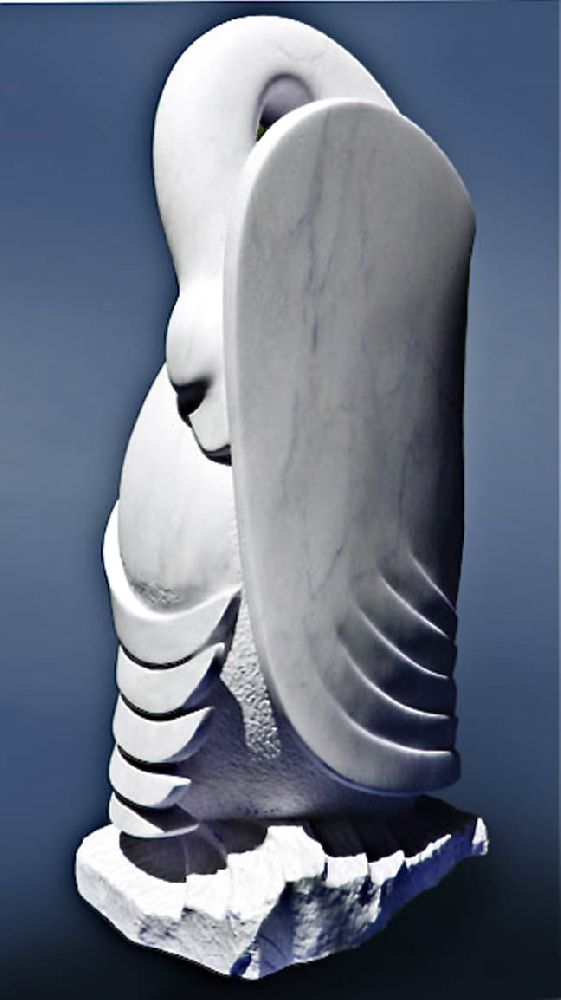

Title: White Carrera Marble Swan Sculpture By Lawrence Juniper
Shipping: $29.00
Artist: N/A
Period: Contemporary
History: N/A
Origin: N/A
Condition: Museum Quality
Item Date: 2010
Item ID: 4690
This is a stunning and affecting showpiece, a museum-quality sculpture meant for prominent display on a pedestal or designated table. You will want to touch her, and in your own private gallery you may! Carved at my studio in Bolinas, California, "Her Feathered Grace" took about a year to complete. She was carved from Italian Carrara marble. The surface is super smooth over most of her, except where I created some texture in isolated areas, where there are natural dimples in the stone, and at the base where I left an area of rough stone. I did it this way because I find the contrast of the highly finished state with the natural state of the marble enhances the tenderness and sensuality of the piece. In the rough edged stone one can see the naturally occurring crystal structure, which glitters. At the same time, the smooth and highly polished marble is what we associate with the great masterpieces; it is awe inspiring, demonstrating the skill of the artist and symbolizing the ideal of perfection and purity. Both of these qualities are inherent in the way we view a white swan. Shipping quotes are available based on location of buyer. Delivery in the state of California is FREE(and in certain other locations may also be)during the month of October. Contact seller for details.
Link: http://en.wikipedia.org/wiki/Carrara
Carrara is a city in the province of Massa-Carrara (Tuscany, Italy), notable for the white or blue-grey marble quarried there. It is on the Carrione River, some 100 kilometres (62 miles) west-northwest of Florence....
Carrara marble has been used since the time of Ancient Rome; the Pantheon and Trajan's Column in Rome are constructed of it. Many sculptures of the Renaissance, such as Michelangelo's David, were carved from Carrara marble. For Michelangelo at least, Carrara marble was valued above all other stone...The Marble Arch in London and the Duomo di Siena are also made from this stone, as are the interiors of Manila Cathedral and the cold-white marbles of the Sheikh Zayed Mosque. (Wikipedia)
Carrara marble is one of the most expensive building materials. ...With its beautiful white or grayish-blue hue, Carrara is a highly desirable marble.
Carrara marble, like all marble, is a metamorphosed limestone. Marble starts its life beneath the Earth's surface as limestone. As the limestone is subjected to heat and pressure through millions of years, it recrystallizes into marble.
The quarries of Carrara, Italy, are where Carrara marble comes from. The marble is blasted off in huge blocks and then taken to a factory to be cut and polished. Today, technology allows quarry workers to use giant cutting machines to remove marble from the quarry, but in the past, they had to use dynamite.
Carrara marble has been favored as a sculpting material throughout history, especially in the Renaissance. Michaelangelo's famous sculpture, "David," is made of Carrara marble.
Carrara marble was used in architecture by the ancient Greeks and Romans....White Carrara marble especially is desirable for its clean, aesthetic qualities.
(Read more: What Is Carrara Marble? | eHow.com http://www.ehow.com/facts_5557348_carrara-marble.html#ixzz1YWllakXd)
Marble sculpture is the art of creating three-dimensional forms from marble. Sculpture is among the oldest of the arts. Even before painting cave walls, early humans fashioned shapes from stone. From these beginnings, artifacts have evolved to their current complexity....Among the commonly available stones only marble has a slight surface translucency that is comparable to that of human skin. It is this translucency that gives a marble sculpture a visual depth beyond its surface and this evokes a certain realism when used for figurative works. Marble also has the advantage that when first quarried it is relatively soft and easy to work, refine, and polish[citation needed]. As the finished marble ages it becomes harder and more durable. Preference to the cheaper and less translucent limestone is based largely on the fineness of marble's grain, which enables the sculptor to render minute detail in a manner not always possible with limestone; it is also more weather resistant. (http://webcache.googleusercontent.com/search?q=cache:QF0_dQNA0yQJ:en.wikipedia.org/wiki/Marble_sculpture+marble+sculpture&cd=1&hl=en&ct=clnk&gl=us&client=firefox-a)